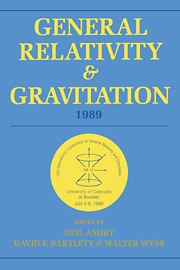 General Relativity and Gravitation, 1989
General Relativity and Gravitation, 1989 Book contents
- Frontmatter
- Contents
- Preface
- Conference committees
- Part A Classical relativity and gravitation theory
- WORKSHOPS
- Part B Relativistic astrophysics, early universe, and classical cosmology
- WORKSHOPS
- Part C Experimental gravitation and gravitational wave detection
- 10 Experimental tests of the universality of free fall and of the inverse square law
- 11 Resonant bar gravitational experiments
- 12 Solar system tests of general relativity: recent results and present plans
- 13 Interferometric gravitational wave detectors
- WORKSHOPS
- Part D Quantum gravity, superstrings, quantum cosmology
- WORKSHOPS
- Part E Overviews-past, present, and future
12 - Solar system tests of general relativity: recent results and present plans
Published online by Cambridge University Press: 05 March 2012
- Frontmatter
- Contents
- Preface
- Conference committees
- Part A Classical relativity and gravitation theory
- WORKSHOPS
- Part B Relativistic astrophysics, early universe, and classical cosmology
- WORKSHOPS
- Part C Experimental gravitation and gravitational wave detection
- 10 Experimental tests of the universality of free fall and of the inverse square law
- 11 Resonant bar gravitational experiments
- 12 Solar system tests of general relativity: recent results and present plans
- 13 Interferometric gravitational wave detectors
- WORKSHOPS
- Part D Quantum gravity, superstrings, quantum cosmology
- WORKSHOPS
- Part E Overviews-past, present, and future
Summary
Introduction
Experimental tests of general relativity are difficult. Physicists were well aware that pregnant new conceptual insights came mostly from young minds. Now, experimentalists must be cut from that mold, previously the exclusive preserve of theorists. Why? The time elapsed between a good idea for an experimental test and its execution is fast approaching the normal human lifetime. Experimenters must now start young-very young-to live to see the fruits of their ideas realized.
I divide the remainder of this paper into two parts, corresponding, respectively, to the past light cone and the future light cone. Under the former rubric, I discuss, in order, tests of the principle of equivalence, light deflection, signal retardation, perihelia advances, geodetic precession, and the constancy of the gravitational “constant.” Under the latter, I mention improved reincarnations of some of these tests, as well as proposed redshift and frame-dragging experiments.
With the proper reference frame established, I move on to the review of recent results and present plans. Because of space and time constraints, much of the treatment is perforce superficial, but, in keeping with the Fourth of July spirit, I shall be democratic and treat all experiments with (almost) equal superficiality.
Past light cone
Principle of equivalence
Space tests of the principle of equivalence have been primarily concerned with measuring the equivalence between gravitational and inertial mass in regard to the contribution to each of gravitational self-energy.
- Type
- Chapter
- Information
- General Relativity and Gravitation, 1989Proceedings of the 12th International Conference on General Relativity and Gravitation, pp. 313 - 330Publisher: Cambridge University PressPrint publication year: 1990
- 30
- Cited by


